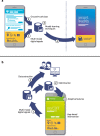Toward clinical digital phenotyping: a timely opportunity to consider purpose, quality, and safety
- PMID: 31508498
- PMCID: PMC6731256
- DOI: 10.1038/s41746-019-0166-1
Toward clinical digital phenotyping: a timely opportunity to consider purpose, quality, and safety
Abstract
The use of data generated passively by personal electronic devices, such as smartphones, to measure human function in health and disease has generated significant research interest. Particularly in psychiatry, objective, continuous quantitation using patients' own devices may result in clinically useful markers that can be used to refine diagnostic processes, tailor treatment choices, improve condition monitoring for actionable outcomes, such as early signs of relapse, and develop new intervention models. If a principal goal for digital phenotyping is clinical improvement, research needs to attend now to factors that will help or hinder future clinical adoption. We identify four opportunities for research directed toward this goal: exploring intermediate outcomes and underlying disease mechanisms; focusing on purposes that are likely to be used in clinical practice; anticipating quality and safety barriers to adoption; and exploring the potential for digital personalized medicine arising from the integration of digital phenotyping and digital interventions. Clinical relevance also means explicitly addressing consumer needs, preferences, and acceptability as the ultimate users of digital phenotyping interventions. There is a risk that, without such considerations, the potential benefits of digital phenotyping are delayed or not realized because approaches that are feasible for application in healthcare, and the evidence required to support clinical commissioning, are not developed. Practical steps to accelerate this research agenda include the further development of digital phenotyping technology platforms focusing on scalability and equity, establishing shared data repositories and common data standards, and fostering multidisciplinary collaborations between clinical stakeholders (including patients), computer scientists, and researchers.
Keywords: Biomarkers; Information technology; Psychiatric disorders.
Conflict of interest statement
Competing interestsH.C. is director of Black Dog Institute which develops apps and internet interventions for mental health but with no personal financial gain. H.C. stands to receive royalties as a creator of Moodgym, but to date no financial gain. H.C., S.V., and K.H. are involved in the development of the Black Dog Institute/Deakin University digital phenotyping platform described in this paper. K.H. and S.V. declare no other competing financial or non-financial interests.
Figures


Similar articles
-
The future of Cochrane Neonatal.Early Hum Dev. 2020 Nov;150:105191. doi: 10.1016/j.earlhumdev.2020.105191. Epub 2020 Sep 12. Early Hum Dev. 2020. PMID: 33036834
-
Digital Phenotyping for Monitoring and Disease Trajectory Prediction of Patients With Cancer: Protocol for a Prospective Observational Cohort Study.JMIR Res Protoc. 2023 Oct 10;12:e49096. doi: 10.2196/49096. JMIR Res Protoc. 2023. PMID: 37815850 Free PMC article.
-
Digital Phenotyping in Livestock Farming.Animals (Basel). 2021 Jul 5;11(7):2009. doi: 10.3390/ani11072009. Animals (Basel). 2021. PMID: 34359137 Free PMC article. Review.
-
Critical Care Network in the State of Qatar.Qatar Med J. 2019 Nov 7;2019(2):2. doi: 10.5339/qmj.2019.qccc.2. eCollection 2019. Qatar Med J. 2019. PMID: 31763205 Free PMC article.
-
Digital phenotyping in Parkinson's disease: Empowering neurologists for measurement-based care.Parkinsonism Relat Disord. 2020 Nov;80:35-40. doi: 10.1016/j.parkreldis.2020.08.038. Epub 2020 Sep 6. Parkinsonism Relat Disord. 2020. PMID: 32937225 Review.
Cited by
-
BioMeT and Algorithm Challenges: A Proposed Digital Standardized Evaluation Framework.IEEE J Transl Eng Health Med. 2020 May 28;8:0700108. doi: 10.1109/JTEHM.2020.2996761. eCollection 2020. IEEE J Transl Eng Health Med. 2020. PMID: 32542118 Free PMC article.
-
Validation of the Mobile App Version of the EQ-5D-5L Quality of Life Questionnaire Against the Gold Standard Paper-Based Version: Randomized Crossover Study.JMIR Form Res. 2022 Aug 11;6(8):e37303. doi: 10.2196/37303. JMIR Form Res. 2022. PMID: 35969437 Free PMC article.
-
Predicting treatment outcome in depression: an introduction into current concepts and challenges.Eur Arch Psychiatry Clin Neurosci. 2023 Feb;273(1):113-127. doi: 10.1007/s00406-022-01418-4. Epub 2022 May 19. Eur Arch Psychiatry Clin Neurosci. 2023. PMID: 35587279 Free PMC article. Review.
-
Returning Individual Research Results from Digital Phenotyping in Psychiatry.Am J Bioeth. 2024 Feb;24(2):69-90. doi: 10.1080/15265161.2023.2180109. Epub 2023 May 8. Am J Bioeth. 2024. PMID: 37155651 Free PMC article.
-
Associations Between Smartphone Keystroke Metadata and Mental Health Symptoms in Adolescents: Findings From the Future Proofing Study.JMIR Ment Health. 2023 May 15;10:e44986. doi: 10.2196/44986. JMIR Ment Health. 2023. PMID: 37184904 Free PMC article.
References
Publication types
LinkOut - more resources
Full Text Sources
Medical

